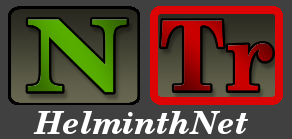|
What is trematode.net, who maintains
it, and how did it start?
Trematode.net is a community resource dedicated to the study of trematodes hosted by
The Genome Institute at Washington University in St. Louis. The site was
established in 2014 as a component of the Helminth.net umbrella site which comprises Nematode.net and Trematode.net (and in the future Cestode.net). The site is the property of
Washington University.
What are trematodes and why do
they matter?
Trematodes are parasitic fluke worms where there are 18,000 to 24,000
different species that infect humans, ruminants and other animals. Most trematode
life cycles involve two host with the intermediate host being a mollusk and a
primary host being a vertabrate. Schistosoma affect almost 240 million people
worldwide, and more than 700 million people live in endemic areas. Food-borne
trematodes infect more than 40 million people worldwide and are acquired by ingestion
of raw or under cooked food that has been contaminated by the parasite in its larval stage.
How are collaborations established?
In total, we've established collaborations with 7 investigators
internationally, providing access to
material from collected trematodes. Species have been selected for 1)
medical or economic importance, 2) use as an accessible system for studies
with an interested scientific community, 3) distribution across the phyla
Trematoda. Individuals interested in establishing collaborations should
contact Makedonka Mitreva mmitreva@genome.wustl.edu.
How do I make use of the various tools presented?
TremaBLAST
TremaBLAST is used to search for your sequence(s) of interest amongst a user defined set of protein sequences representing the genesets of our hosted trematode organisms (that have genesets available). Databases may include the protein products of predicted and/or final genes from draft and/or finished genomic assemblies. Where multiple isoforms were predicted, the TremaBLAST database will only utilize the longest isoform per gene loci."
I used TremaBLAST and blasted against multiple organisms. How do I figure out which organisms my sequence hit?
Here is an index with the organisms and the abbreviated names referenced in the TremaBLAST results:
Clonorchis sinensis (50HG assembly version: 3.5) CS1
Echinostoma caproni (50HG assembly version: 1.5.4) ECPE
Fasciola hepatica (50HG assembly version: 1.0) D915
Schistosoma curassoni (50HG assembly version: 1.0.4) SCUD
Schistosoma haematobium (50HG assembly version: 3.0) MS3
Schistosoma japonicum (50HG assembly version: 1.0) SJC
Schistosoma mansoni (50HG assembly version: 5.2) SMP
Schistosoma margrebowiei (50HG assembly version: 1.5.4) SMRZ
Schistosoma mattheei (50HG assembly version: 1.0.4) SMTD
Schistosoma rodhaini (50HG assembly version: 1.0.4) SROB
Trichobilharzia regenti (50HG assembly version: 1.0.4) TRE
TremaGene
Most access into the TremaGene database comes from other tools within the Trematode.net site such as the gene links from TremaPath which directly jumps to the details pages that are the terminus of a TremaGene search. But the TremaGene search form can also be of use when you have identified a gene or transcript from some other Trematode.net resources and want more detail on that sequence entity.
TremaPath Pathways
TremaPath provides information about the presence, absence and composition of enzymatic pathways in given organisms based on actual transcript data and allows for the comparison of any two organisms represented in the database. This is useful in many ways, from identifying potential drug targets to helping understand the differences between species utilizing different survival strategies. The ability to directly compare any two species in the database provides a direct visualization of enzymatic differences between the two.
TremaBrowse
TremaBrowse is a collection of trematode genomes annotated with gene predictions and displayed using the GBrowse interface. Gene names are those assigned by the various gene calling mechanisms employed during gene prediction and may be subject to change. Minimal annotation is made available in the gene list using final gene product information as annotated by the BER pipeline.
|




